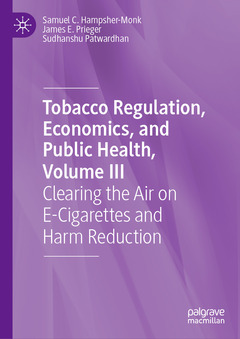Tobacco Regulation, Economics, and Public Health, Volume III, 1st ed. 2024 Clearing the Air on E-Cigarettes and Harm Reduction
Auteurs : Hampsher-Monk Samuel C., Prieger James E., Patwardhan Sudhanshu

What role should the tobacco industry have in the e-cigarette market? Should manufacturers contribute to the production of evidence on their products? safety and efficacy? What are the environmental impacts of e-cigarette use and how should these feature in the discussion? How do e-cigarettes influence smoking-related health disparities? Should physicians recommend switching to e-cigarettes for those who smoke? How broadly applicable is the utility of e-cigarettes? And how should the discourse respond to emerging data? This volume examines the opportunities and challenges of optimizing e-cigarette regulation. The authors describe emerging evidence suggesting that restrictions on e-cigarettes can backfire by nudging consumers toward riskier alternatives. Adopting a social welfare-based approach drawing on economics, policy analysis and regulatory science, the authors then explore how optimal e-cigarette policy might balance risks and benefits, suggesting that it is possible to leverage the promise of e-cigarettes?a product that is more popular than traditional cessation aids?to protect current and future generations from the smoking-related harms, while still taking important steps to discourage use by young people and those who do not smoke.
Chapter 1: E-cigarette regulations and why they fail
- The recent history of e-cigarette regulation
- Contemporary approaches to e-cigarette regulation
- Evaluating e-cigarette regulation
- Why do we have sub-optimal e-cigarette policies?
Chapter 2: Towards optimal e-cigarette policy
- What can regulators do?
- First principles of e-cigarette regulation
- The dual imperatives and the centrality of trade-offs
- Existing models of the risks and benefits for the population
- Pursuing optimal e-cigarette regulation
- The devil is in the details: Optimizing differential nicotine regulation
- Further considerations for optimizing e-cigarette regulation
- Appropriate e-cigarette regulations complement tobacco control
- How do we get there from here?
Chapter 3: Remaining questions
- What are the remaining knowledge gaps, and how can these be filled?
- If smoking rates are declining, why do we need e-cigarettes?
- Why should we allow tobacco companies to profit from the sale of e-cigarettes?
- Should we ignore all research on tobacco and nicotine conducted by industry?
- Is increased nicotine use a price worth paying for less smoking?
- What are the environmental impacts of e-cigarettes, and can these be mitigated?
- Do e-cigarettes help or hinder smoking-related disparities?
- Are e-cigarettes an appropriate solution for smoking in all contexts?
- Can we export “lessons learned” from one geographical context to another?
- How should regulation respond to shifting consumption patterns?
- Should physicians recommend e-cigarettes to smokers?
- Wouldn’t it be better to provide e-cigarettes as a medical product?
- Should we encourage young smokers to switch to e-cigarettes too?
- Should public resources be used to support vaping cessation?
- Could e-cigarettes allow us to eventually ban smoking?
- Can we agree to disagree about optimal e-cigarette regulation?
Chapter 4: Conclusions
Samuel C. Hampsher-Monk is Managing Director of BOTEC Analysis, where he leads research on the regulation of tobacco, cannabis, and reduced-risk nicotine products for public and private clients, including 501(c)(3) groups and LLPs, as well as municipal and state regulators. He holds a BA in Politics and Philosophy from the University of Southampton and a MSc from the University of Edinburgh.
James E. Prieger, an economist, is Professor of Public Policy at Pepperdine University and Senior Researcher at BOTEC Analysis, where he leads research on illicit tobacco markets, alternative nicotine products, and related policy issues. He has published over 50 peer-reviewed journal articles and chapters. He received his BA from Yale University and his PhD in economics from the University of California, Berkeley.
Sudhanshu Patwardhan is a medical doctor working on tobacco harm reduction projects globally. He has worked in R&D in the pharma and tobacco sectors across three continents. Patwardhan qualified as a doctor from BJ Medical College Pune, India, received a Master of Business and Science from the Keck Graduate Institute, California, USA, and holds an MBA from the London Business School, UK
Explores why current vaping regulation often leads to unintended consequences
Uses economic analysis to discuss how optimal regulation of e-cigarettes differs from the status quo
Explores whether e-cigarettes should be licensed as medical products
Date de parution : 05-2024
Ouvrage de 218 p.
14.8x21 cm
Thème de Tobacco Regulation, Economics, and Public Health, Volume III :
Mots-clés :
e-cigarettes; vaping and health; vaping safer than smoking; danger vaping; vaping; quit smoking



